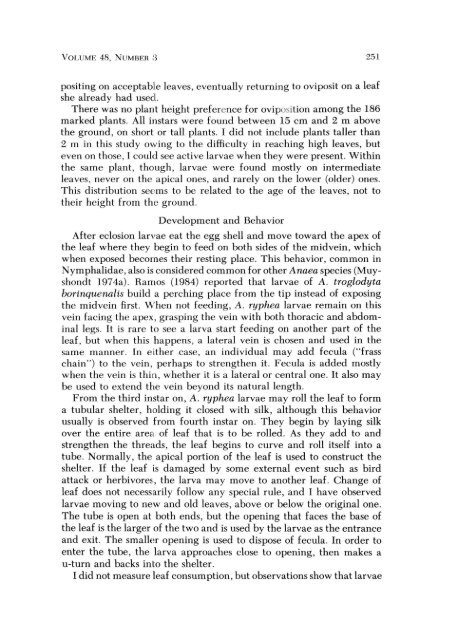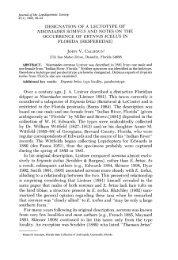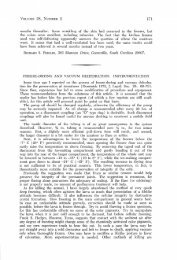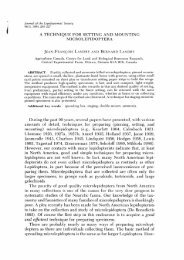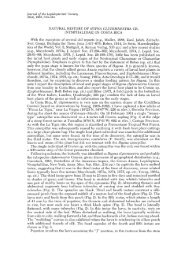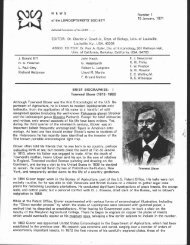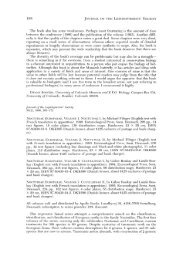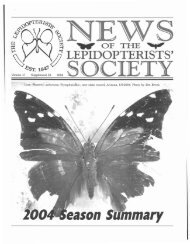Biology of Anaea ryphea - Yale University
Biology of Anaea ryphea - Yale University
Biology of Anaea ryphea - Yale University
You also want an ePaper? Increase the reach of your titles
YUMPU automatically turns print PDFs into web optimized ePapers that Google loves.
VOLUME 48, NUMBER ;) 251<br />
positing on acceptablle leaves, eventually returning to oviposit on a leaf<br />
she already had used.<br />
There was no plant height preference for oviposition among the 186<br />
marked plants. All instars were found between 15 cm and 2 m above<br />
the ground, on short or tall plants. I did not include plants taller than<br />
2 m in this study owing to the difficulty in reaching high leaves, but<br />
even on those, I could see active larvae when they were present. Within<br />
the same plant, though, larvae were found mostly on intermediate<br />
leaves, never on the apical ones, and rarely on the lower (older) ones.<br />
This distribution seems to be related to the age <strong>of</strong> the leaves, not to<br />
their height from the ground.<br />
Development and Behavior<br />
After eclosion larvae eat the egg shell and move toward the apex <strong>of</strong><br />
the leaf where they begin to feed on both sides <strong>of</strong> the midvein, which<br />
when exposed becomes their resting place. This behavior, common in<br />
Nymphalidae, also is considered common for other <strong>Anaea</strong> species (Muyshondt<br />
] 974a). Ramos (1984) reported that larvae <strong>of</strong> A. troglodyta<br />
borinquenalis build a perching place from the tip instead <strong>of</strong> exposing<br />
the midvein first . \Vhen not feeding, A. <strong>ryphea</strong> larvae remain on this<br />
vein facing the apex, grasping the vein with both thoracic and abdominal<br />
legs. It is rare to see a larva start feeding on another part <strong>of</strong> the<br />
leaf, but when this happens, a lateral vein is chosen and used in the<br />
same manner. In either case, an individual may add fecula ("frass<br />
chain") to the vein, perhaps to strengthen it. Fecula is added mostly<br />
when the vein is thin, whether it is a lateral or central one. It also may<br />
be used to extend the vein beyond its natural length.<br />
From the third instar on, A. <strong>ryphea</strong> larvae may roll the leaf to form<br />
a tubular shelter, holding it closed with silk, although this behavior<br />
usually is observed from fourth instar on. They begin by laying silk<br />
over the entire area <strong>of</strong> leaf that is to be rolled. As they add to and<br />
strengthen the threads, the leaf begins to curve and roll itself into a<br />
tube. Normally, the apical portion <strong>of</strong> the leaf is used to construct the<br />
shelter. If the leaf is damaged by some external event such as bird<br />
attack or herbivore~, the larva may move to another leaf. Change <strong>of</strong><br />
leaf does not necessarily follow any special rule, and I have observed<br />
larvae moving to new and old leaves, above or below the original one.<br />
The tube is open at both ends, but the opening that faces the base <strong>of</strong><br />
the leaf is the larger <strong>of</strong> the two and is used by the larvae as the entrance<br />
and exit. The smaller opening is used to dispose <strong>of</strong> fecula. In order to<br />
enter the tube, the larva approaches close to opening, then makes a<br />
u-turn and backs into the shelter.<br />
I did not measure leaf consumption, but observations show that larvae


